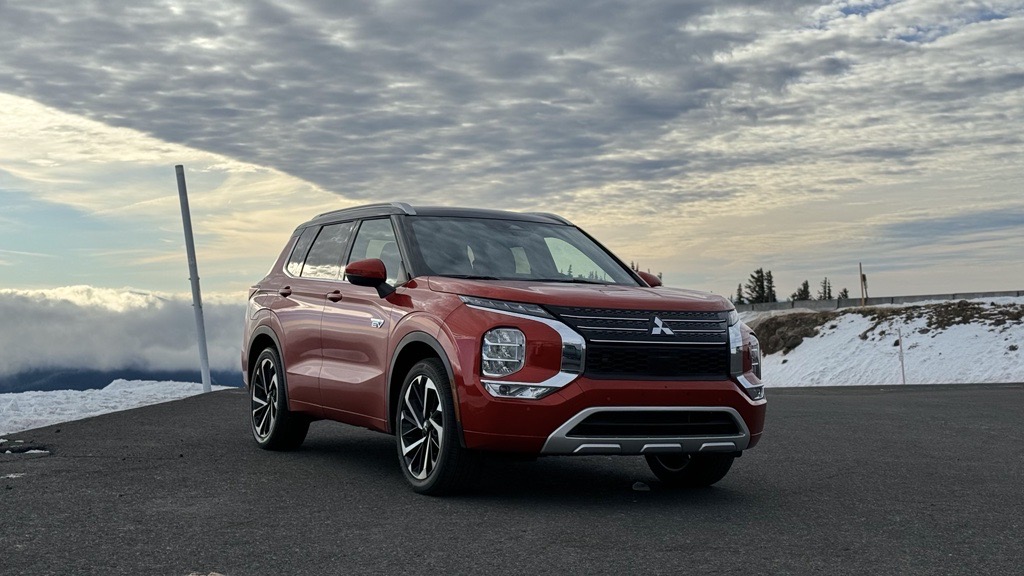
The Mitsubishi Outlander Plug-in Hybrid is surprisingly good. So good it makes up most of Mitsubishi’s sales in North America. Mitsubishi also feels it’s good enough to be your daily driver, no matter what conditions you encounter.
So, we encountered some approachably tricky conditions with the Outlander Plug-in Hybrid. On two recent drives, we took the Outlander into the hills of Tennessee on a muggy Fall day and into the mountains during a mild winter in the Pacific Northwest. We test-drove the Mitsubishi Outlander SEL Premium.
We wanted to see:
- If the Outlander was as capable offroad as it is on-road
- If its traction control systems balked when used under challenging settings
- If we were left hesitant to replicate our driving situations

What we like about the Mitsubishi Outlander Plug-in Hybrid
- The Outlander is stylish. If you’re buying an SUV for daily driving scenarios, it should be cool, right? The Mitsubishi Outlander looks sharp, and its interior is well-equipped and stylish, too.
- The Super All-Wheel Control (AWC) system is great. AWC monitors things like acceleration and wheel slippage to enhance the all-wheel drive (AWD) system, and it’s great. You can feel that it’s simply more engaged and active than a traditional AWD system, which often slips or “fails” before correcting.
- It has smooth driving dynamics. Not the sportiest SUV we’ve ever tested, the Mitsubishi Outlander is a great drive. Smooth, capable, and assured on the road, it’s equally adept when things get treacherous.
- It’s stylish – but still rugged. I wouldn’t take the Outlander on a rally race in the desert, but it’s capable of handling the situations you might actually find yourself in. I’d happily take the Outlander on a camping excursion that required some traversing into the deep woods.
- Drive modes are performant and don’t alter driving dynamics. Slip it into “snow” mode, and the Outlander feels no different. Some vehicle modes on other SUVs we’ve tested can’t say this; in those moments, it feels like a different car altogether.
- Hill descent control is surprisingly good. Mitsubishi has an excellent hill descent control system. We found it limited speed better than other vehicles we’ve tested in similar scenarios, which is comforting in a stressful situation.
What to consider before buying a Mitsubishi Outlander
- Has a lower MPGe than the competition. The Outlander Plug-in Hybrid MPGe is right around 64 MPGe. Competing PHEV vehicles in this class often start around 80 MPGe.
- Noticeable “whine” from the electric motor. This is common for plug-in hybrids, but the Outlander Plug-in Hybrid electric engine noise is too noticeable. Luckily, you get used to it over time.
Should you buy a Mitsubishi Outlander Plug-in Hybrid?
We think that for $50,000, the Mitsubishi Outlander Plug-in Hybrid is a great option if you’re looking for an SUV – and most are these days. It’s capable off-road, performs in winter on-road conditions, and never gives us pause. We encountered icy roads, rough backroad trails, and snowy gravel paths. Driving normally (because why try to make a vehicle fail?), there were no issues with the two Outlander SEL models we drove.
Our review wasn’t meant to test how the Outlander Plug-in Hybrid drives day-to-day. Honestly, it’s a great daily driver, but there’s nothing sensational about Outlander as a daily driver that warrants us discussing it in this article. It’s a rock-solid performer in everyday situations, but you’ll figure that out on your own when you test-drive it.
Those moments where you have to go off-road or encounter sketchy road conditions matter more than we realize, and the Outlander is fantastic in those situations. A good SUV can handle unique driving situations well; a great SUV handles them with aplomb.
The Mitsubishi Outlander Plug-in Hybrid handles varied driving conditions with aplomb.



